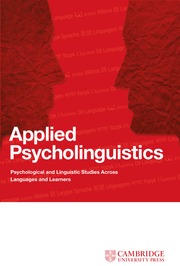Crossref Citations
This article has been cited by the following publications. This list is generated based on data provided by
Crossref.
Kristmanson, Paula
and
Dicks, Joseph
2014.
Looking in the one-way mirror.
Journal of Immersion and Content-Based Language Education,
Vol. 2,
Issue. 2,
p.
273.
Genesee, Fred
and
Fortune, Tara W.
2014.
Bilingual education and at-risk students.
Journal of Immersion and Content-Based Language Education,
Vol. 2,
Issue. 2,
p.
196.
Tamhane, Ashay
Ikbal, Shajith
Sengupta, Bikram
Duggirala, Mayuri
and
Appleton, James
2014.
Predicting student risks through longitudinal analysis.
p.
1544.
Bourgoin, Renée
2014.
The Predictive Effects of L1 and L2 Early Literacy Indicators on Reading in French Immersion.
The Canadian Modern Language Review,
Vol. 70,
Issue. 3,
p.
355.
Ikbal, S.
Tamhane, A.
Sengupta, B.
Chetlur, M.
Ghosh, S.
and
Appleton, J.
2015.
On early prediction of risks in academic performance for students.
IBM Journal of Research and Development,
Vol. 59,
Issue. 6,
p.
5:1.
BELLOCCHI, STÉPHANIE
BONIFACCI, PAOLA
and
BURANI, CRISTINA
2016.
Lexicality, frequency and stress assignment effects in bilingual children reading Italian as a second language.
Bilingualism: Language and Cognition,
Vol. 19,
Issue. 1,
p.
89.
Dicks, Joseph
and
Genesee, Fred
2016.
Bilingual and Multilingual Education.
p.
1.
Edyburn, Kelly L.
Quirk, Matthew
Felix, Erika
Swami, Sruthi
Goldstein, Ariel
Terzieva, Antoniya
and
Scheller, Jennifer
2017.
Literacy Screening Among Latino/a and Dual Language Learner Kindergarteners: Predicting First Grade Reading Achievement.
Literacy Research and Instruction,
Vol. 56,
Issue. 3,
p.
250.
Kormos, Judit
2017.
The Effects of Specific Learning Difficulties on Processes of Multilingual Language Development.
Annual Review of Applied Linguistics,
Vol. 37,
Issue. ,
p.
30.
Dicks, Joseph
and
Genesee, Fred
2017.
Bilingual and Multilingual Education.
p.
453.
Le Bouthillier, Josée
2017.
A sociocognitive model of interventions for writing instruction.
Journal of Immersion and Content-Based Language Education,
Vol. 5,
Issue. 2,
p.
265.
Savage, Robert
Kozakewich, Meagan
Genesee, Fred
Erdos, Caroline
and
Haigh, Corinne
2017.
Predicting writing development in dual language instructional contexts: exploring cross‐linguistic relationships.
Developmental Science,
Vol. 20,
Issue. 1,
Cammarata, Laurent
Cavanagh, Martine
Blain, Sylvie
and
Sabatier, Cécile
2018.
Enseigner en immersion française au Canada : synthèse des connaissances sur les défis et leurs implications pour la formation des enseignants.
The Canadian Modern Language Review,
Vol. 74,
Issue. 1,
p.
101.
Savage, Robert
McBreen, Miriam
Genesee, Fred
Erdos, Caroline
Haigh, Corinne
and
Nair, Aishwarya
2018.
Rapid automatic naming predicts more than sublexical fluency: Evidence from English-French bilinguals.
Learning and Individual Differences,
Vol. 62,
Issue. ,
p.
153.
Kormos, Judit
Košak Babuder, Milena
and
Pižorn, Karmen
2019.
The Role of Low-level First Language Skills in Second Language Reading, Reading-While-Listening and Listening Performance: A Study of Young Dyslexic and Non-dyslexic Language Learners.
Applied Linguistics,
Vol. 40,
Issue. 5,
p.
834.
Geva, Esther
Xi, Yueming
Massey-Garrison, Angela
and
Mak, Joyce Y.
2019.
Reading Development and Difficulties.
p.
117.
Kay-Raining Bird, Elizabeth
Genesee, Fred
Sutton, Ann
Chen, Xi
Oracheski, Joan
Pagan, Stephanie
Squires, Bonita
Burchell, Diana
and
Sorenson Duncan, Tamara
2021.
Access and outcomes of children with special education needs in Early French Immersion.
Journal of Immersion and Content-Based Language Education,
Vol. 9,
Issue. 2,
p.
193.
Nic Aindriú, Sinéad
Duibhir, Pádraig Ó
and
Travers, Joe
2021.
A Survey of Assessment and Additional Teaching Support in Irish Immersion Education.
Languages,
Vol. 6,
Issue. 2,
p.
62.
Maurer, U.
Jost, L. B.
Pfenninger, S. E.
and
Eberhard-Moscicka, A. K.
2021.
Effects of German reading skills and bilingualism on early learning of English as a foreign language in primary school children.
Reading and Writing,
Vol. 34,
Issue. 10,
p.
2673.
Karimijavan, Gelavizh
Ebadi, Abbas
Yadegari, Fariba
Dastjerdi Kazemi, Mehdi
Darouie, Akbar
and
Karimi, Salah Eddin
2021.
Sequential bilingualism and language impairment: the Persian version of ALDeQ parental questionnaire.
Early Child Development and Care,
Vol. 191,
Issue. 5,
p.
815.

